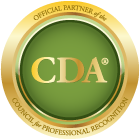 If you’re working or thinking about working in #early-childhood-education in Minnesota, earning a Child Development Associate (CDA) credential can be a smart move. This article explains how CDA works in Minnesota: what it is, how it is recognized, how to get one, and why it matters for child-care providers in the state.
If you’re working or thinking about working in #early-childhood-education in Minnesota, earning a Child Development Associate (CDA) credential can be a smart move. This article explains how CDA works in Minnesota: what it is, how it is recognized, how to get one, and why it matters for child-care providers in the state.
What Is the CDA Credential
The CDA is a nationally recognized credential awarded by the Council for Professional Recognition.
It shows that an #early-childhood- #educator has met certain standards for training, experience, and demonstrated ability to provide quality care and education to young children.
The CDA can be earned for different early-childhood settings (infant/ #toddler, #preschool, family child care, etc.), though requirements may vary depending on setting and state regulations.
In Minnesota, the CDA is part of the official #career pathway for early #educators — recognized under the state’s system as a valid credential for many child-care roles.
Why CDA Matters in Minnesota
Career Lattice Recognition
Minnesota organizes #early-childhood workers’ progress and qualifications through a “Career Lattice.” Earning a valid CDA puts you at Step 6 on the lattice.
That means:
-
With a CDA, you meet one of the recognized credentialing options for early childhood professionals — even without a college degree.
-
It can make you eligible for better opportunities, higher pay, or roles that require credentialed #staff (especially in family child care, licensed centers, or programs receiving quality-based funding).
Quality Incentives for Licensed or Family Child Care Providers
For licensed family child-care providers or legal nonlicensed providers participating in subsidy or funding programs, holding a CDA can influence eligibility for higher quality-based payments. For example, certain state support or incentive programs consider the CDA among the credentials that qualify providers for enhanced rates or quality recognition.
Professional and Personal Growth
Earning the CDA helps build knowledge and skills in early childhood #development, curriculum planning, caregiving, #safety, and child-centered teaching practices — serving both as foundational training and a stepping stone toward further professional development.
How to Get a CDA in Minnesota
Getting your CDA credential in Minnesota typically involves the following steps:
-
Complete required training (often through state-approved programs)
-
Gain practical experience working with young children
-
Assemble a professional portfolio
-
Pass the CDA assessment/exam and verification visit
State-Supported CDA Pathways: MNCDA & MNITCDA
In Minnesota, the program Child Care Aware of Minnesota (often called “Child Care Aware MN”) administers state-supported CDA pathways:
-
MNCDA — the standard CDA training program for center-based or family child care professionals.
-
Also, there is an infant/toddler-specific variant called MNITCDA for those working with younger children.
These programs typically include eight instructor-led online modules (through the “Eager-to-Learn” platform), and training may be completed in as little as 4–6 months.
What’s great about MNCDA / MNITCDA:
-
They offer flexibility — you can take only the modules you still need, depending on any previous training.
-
There is #personalized support: a CDA Consultant helps with portfolio development, exam preparation, and verification process.
-
Often there is financial support available: grants or subsidies to help pay training and application fees.
Financial Support via Minnesota CDA Reimbursement
If you work or volunteer at a licensed or license-exempt early childhood program in Minnesota, you may qualify for reimbursement or financial support when pursuing your CDA or renewing it.
For example:
-
Up to $600 toward initial CDA training
-
Up to $300 toward application fees (or subsidy for renewal fee)
-
Eligibility depends on having a valid “Develop Individual Membership” and verified employment via the state’s system.
This support helps make CDA more accessible — even for educators who may not have the personal funds to pay upfront.
What Happens After You Get a CDA
Once you’ve earned the CDA credential and had it verified in the state system, here’s how things often progress:
-
Your credential shows up on your “Develop Individual Profile” (the state’s professional registry) after you send in a copy of your official CDA award certificate.
-
You’re officially recognized at Step 6 on the Career Lattice — which may qualify you for certain roles, responsibilities, or increased compensation.
-
If you work in licensed or subsidy-based child care (especially family child care), having a CDA can help with quality-based funding or incentive programs.
-
For those seeking to advance further (e.g. into #lead #teacher roles, supervision, or higher credentials), the CDA can serve as a solid foundation — though additional education (college credits, degree) may still be needed depending on the role.
Using Online Courses (e.g. via ChildCareEd) to Get/Support CDA in Minnesota
If you prefer online self-paced learning, organizations like ChildCareEd can help — and they offer Minnesota-friendly options. For instance:
-
ChildCareEd has a Minnesota CDA Fee & Training Reimbursement page that outlines support for Minnesota educators seeking CDA certification or renewal.
-
The online courses are structured to meet CDA training requirements and can serve as an accessible path for those balancing work or personal schedules.
📘 A good place to start: Check out ChildCareEd’s online CDA training offerings on the site.
As a resource for Minnesota providers, the reimbursement/grant program is particularly helpful — it reduces cost barriers and makes certification more attainable.
What Minnesota Regulators Accept as Qualifying Credentials
For licensed family child-care providers or legal nonlicensed providers in Minnesota, the regulatory framework lists acceptable credentials that allow participation in certain quality or subsidy-based programs. Among those, the CDA credential is explicitly named.
Other acceptable credentials include:
-
A diploma in child development from a Minnesota state technical college
-
An associate degree in child development or early childhood education
-
A bachelor’s or post-baccalaureate degree in early childhood education from an accredited college/university
-
Accreditation by the National Association for Family Child Care (NAFCC) for licensed family child care providers
If you choose to pursue CDA — especially through an approved route like MNCDA or with recognized documentation — you meet one of the primary credential options accepted by Minnesota’s licensing and child-care assistance systems.
Pros & Limitations of the CDA in Minnesota
Advantages:
-
Widely recognized credential that does not require a full college degree
-
Helps meet Minnesota’s credential/qualification requirements for family-care providers and many early childhood jobs
-
Serves as an accessible career entry point or stepping stone toward higher credentials or degrees
-
Often eligible for financial support/subsidies (via reimbursements, scholarships) — especially helpful for those with limited resources
Things to Know / Limitations:
-
CDA is not the same as a college degree — many higher-level roles (lead teacher, director, or school-based teaching) may require additional education or licenses.
-
For training to count toward state-recognized credentialing or reimbursement, it must be done through approved programs (e.g. those registered in the state’s “Develop” system) and properly verified.
-
If you let your CDA lapse (credential expires) and you don’t renew, you may lose the recognized status until renewal is complete.
Getting Started: Steps to Earn a CDA in Minnesota
If you’re ready to begin your CDA journey in Minnesota, here’s a simple plan:
-
Connect with a state-approved program — such as MNCDA or MNITCDA through Child Care Aware MN.
-
Register for training — complete online instructor-led modules or cohort sessions; ChildCareEd may offer online, self-paced options and help you with reimbursement applications.
-
Work while you learn — you can usually continue working while completing coursework, making CDA a flexible option for working caregivers/ #teachers.
-
Build your portfolio and submit application — gather required documentation, do the assessment, and go through the verification process.
-
Verify credential in the state registry — send your CDA certificate to update your “Develop Individual Profile,” thereby legitimizing your credentials for employers and funding agencies.
-
Leverage your credential — once you have the CDA, pursue roles that value credentialed educators (lead, assistant, family child care), and consider further education or #growth opportunities.
Conclusion
For #early-childhood-educators in Minnesota, the CDA credential offers a valuable, recognized, and practical pathway to establishing professional credibility, meeting licensing/quality standards, and advancing in the field. Because Minnesota accepts CDA as a valid qualification under its licensing and subsidy systems — and because of available state-supported training and reimbursement programs — it’s often a smart first credential.
If you’re interested in beginning your CDA journey, one great place to start is with ChildCareEd’s Minnesota-friendly training and reimbursement program.
🟦 Stay connected and get more early childhood education resources and updates by following ChildCareEd — for instance, on Instagram.


